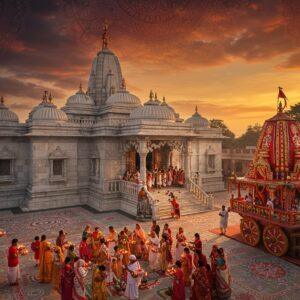
Tucked away in the Balasore district of Odisha, close to the Bengal border, lies a sanctuary of immense spiritual power and historical depth – the Chandaneswar Temple. More than just a place of worship, this sacred abode of Lord Shiva is a vibrant tapestry of faith, culture, and timeless architecture. For centuries, it has drawn countless devotees and curious travellers, all seeking to immerse themselves in its divine aura and connect with a heritage that feels as ancient as time itself.

The Storied Past: Legends Whispering Through Time
The origins of Chandaneswar Temple are believed to stretch back over a thousand years into the medieval era. Local lore lovingly connects its inception to King Mayuradhwaj of the Somavamsi dynasty, a ruler known for his unwavering devotion to Mahadev.
The name ‘Chandaneswar’ itself is beautifully poetic. It is said to be derived from the Sanskrit word ‘Chandana’, which means sandalwood. This symbolises the fragrant, soothing, and divine presence of Lord Shiva. Another beautiful story tells of a devout sage, Chandana Muni, to whom Lord Shiva revealed himself in this very spot. The heart of the temple’s spiritual magnetism, however, lies in its Shiva Lingam, which is revered as a Swayambhu or self-manifested lingam, making it an incredibly powerful and auspicious site for worship.
An Architectural Marvel Carved in Stone
The temple is a breathtaking example of the classic Kalinga style of architecture, a sight that fills one with awe. Its design features intricate carvings, soaring spires (shikharas), and a grandeur that speaks of a glorious past. While rooted in Kalinga craftsmanship, one can also notice a delicate blend of Dravidian influences, creating a truly unique architectural identity.
- The Sanctum and Hall: The temple structure includes a majestic, towering Vimana (the main sanctum tower) built in the Rekha Deula style, and a spacious Jagamohan (assembly hall) where devotees can gather for prayers and reflection.
- Sacred Materials and Idols: Constructed from laterite and sandstone, typical of ancient Odia temples, the complex feels deeply connected to the earth it stands on. Inside, devotees are greeted by a magnificent 12-foot-high Shiva Lingam and a striking black stone statue of Nandi, Shiva’s eternal mount and devotee. The temple complex also provides a spiritual home to other deities, with smaller shrines dedicated to Goddess Kali, Lord Hanuman, and Lord Jagannath.

The Heartbeat of Culture and Community Faith
Chandaneswar Temple is far more than a historical monument; it is the living, breathing heart of the region’s culture. Lord Shiva is lovingly worshipped here as Baba Chandaneswar, considered the Kshetrapal or the divine guardian of the entire area. The temple is a vital centre for preserving the rich Shaivite traditions shared by both Odia and Bengali communities, fostering a unique cultural harmony.
Festivals and Sacred Rituals: A Celebration of Devotion
The temple truly comes alive during its festivals, which are grand celebrations of faith and cultural vibrancy. The most significant of these is the Chaitra Mela, an annual fair held in the month of Chaitra (March-April). It’s a spectacular event that attracts devotees from all walks of life. The air buzzes with energy from colourful stalls, traditional music, and dance performances. A unique highlight is the Kamina Baha, the symbolic marriage of Lord Shiva, celebrated with great joy.
Maha Shivaratri is another major festival, observed with profound devotion through night-long vigils, fasting, and chanting. Devotees perform sacred rituals like offering sandalwood paste (chandan) and Bilva Patra (bel leaves) to the Lingam. To truly partake in these sacred traditions, having the right pooja samagri is essential. At Poojn.in, we ensure you have access to authentic, high-quality items to make your offerings pure and heartfelt.
Planning Your Sacred Journey: A Visitor’s Guide
A trip to Chandaneswar Temple is an experience that stays with you. To make the most of your visit, it’s a good idea to plan ahead. Many find that visiting during the festive periods of Chaitra Mela or Maha Shivaratri offers an unparalleled, immersive experience into the local culture.
The temple is located in the Balasore district and is easily reachable by road. For those travelling by train, the nearest railway station is Jaleswar, which is well-connected to major cities. Once you arrive, remember that this is a sacred space. Wearing modest and respectful holy clothing is appreciated. While you can usually take pictures in the outer premises, photography is often restricted inside the main sanctum to maintain its sanctity. The temple authorities provide basic facilities for pilgrims, ensuring a comfortable visit. For those looking to explore more, the serene Talsari Beach is just a short drive away, offering a perfect, peaceful end to a spiritual day.
The temple is generally open for devotees from early morning until evening. However, it is always wise to check the specific timings locally before you plan your trip, especially during festivals when hours may be extended.
Embrace the Sacred Legacy
Chandaneswar Temple stands as a powerful beacon of spirituality, a place where history is etched in stone and faith echoes in every prayer. It invites you to step away from the mundane and connect with something deeper. Whether you are seeking spiritual solace, architectural wonder, or a genuine cultural experience, this sacred destination in the heart of Odisha offers it all. Come, embrace its sacred legacy and let the timeless mystique of Baba Chandaneswar fill your heart.


